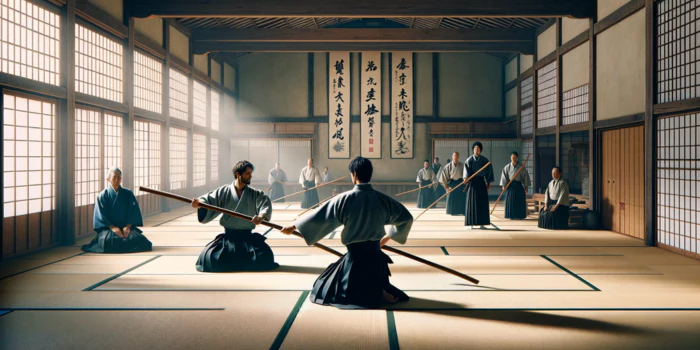Katori Shinto Ryu is one of Japan’s oldest and most respected martial arts schools, with a history that stretches back over 600 years. This classical school, or “koryu,” is not just a collection of techniques but a comprehensive martial system that encompasses a wide range of skills, including swordsmanship, spear fighting, and strategy. One of the critical aspects of Katori Shinto Ryu is its approach to blocking, an essential skill that reflects the philosophy and principles of this ancient martial art.
The Philosophy Behind Blocking in Katori Shinto Ryu
In Katori Shinto Ryu, blocking is more than just a physical act of defense; it is a manifestation of the practitioner’s understanding of timing, distance, and strategy. The blocks in Katori Shinto Ryu are designed to neutralize an opponent’s attack while simultaneously positioning the practitioner for a counterattack. This dual purpose of defense and offense is central to the art, reflecting the idea that a block should never be a passive action but an integral part of a broader strategy.
In Katori Shinto Ryu, the philosophy of blocking deeply roots itself in the concept of “Sen no Sen,” which refers to anticipating an opponent’s move and acting in response before the attack fully develops. This proactive approach to blocking requires a high level of awareness, timing, and precision, allowing the practitioner to control the flow of combat and turn defense into an opportunity for victory.
Techniques of Blocking in Katori Shinto Ryu
- Uke Nagashi: This technique involves a sweeping motion that deflects the opponent’s attack to the side. Rather than meeting the force head-on, Uke Nagashi redirects the energy, allowing the practitioner to maintain balance and control. This block is often used against diagonal or vertical strikes and is typically followed by a counterattack.
- Kiri Otoshi: A powerful downward block, Kiri Otoshi is used to intercept an overhead strike. The practitioner brings their sword down with a cutting motion, meeting the attack with both force and precision. This block is designed to overpower the opponent’s strike and create an opening for a decisive counterattack.
- Nuki Uchi: This is a dynamic block that involves drawing the sword while simultaneously deflecting an attack. Nuki Uchi is particularly effective against surprise or close-range attacks, where quick reflexes and precise timing are crucial. The block is executed as the sword is drawn from its scabbard, allowing the practitioner to transition smoothly into an offensive move.
- Makki Uke: A circular blocking technique, Makki Uke is used to absorb and neutralize the force of an attack. The circular motion of the block not only deflects the strike but also unbalances the opponent, making it easier to follow up with a counterattack. This block is particularly effective against thrusts and linear attacks.
- Tsuki Uke: This block is specifically designed to deal with thrusting attacks. By using the flat of the blade or the side of the body, the practitioner deflects the thrust while stepping off the line of attack. Tsuki Uke emphasizes the importance of footwork in Katori Shinto Ryu, as proper movement is essential to avoiding the full force of the opponent’s strike.
The Role of Blocking in Katori Shinto Ryu Training
Training in Katori Shinto Ryu involves rigorous practice of these blocking techniques, often through kata, or pre-arranged forms, which simulate combat scenarios. These kata are performed with a partner, allowing practitioners to experience the timing, distance, and energy dynamics of real combat. Through repetitive practice, students develop muscle memory and reflexes that enable them to execute blocks instinctively and effectively.
However, Katori Shinto Ryu also emphasizes the importance of understanding the principles behind each technique. Practitioners should think critically about the purpose of each block, how it fits into the overall strategy of a confrontation, and how to adapt it to different situations. This intellectual approach to training helps students internalize the art’s deeper philosophy and apply it in both martial and everyday contexts.
The Significance of Blocking in Katori Shinto Ryu
Blocking in Katori Shinto Ryu is a reflection of the art’s holistic approach to combat. Where every movement serves a dual purpose of defense and offense. By mastering the art of blocking, practitioners of Katori Shinto Ryu not only learn to protect themselves. But also gain the ability to dominate and overcome their opponents.
In conclusion, the art of blocking in Katori Shinto Ryu is a testament to the depth. Sophistication of this ancient martial tradition. It is an essential skill that embodies the principles of timing, and strategy. Adaptability plays a crucial role in the broader context of Katori Shinto Ryu’s comprehensive martial system. Through diligent practice and thoughtful study, practitioners can unlock the full potential of these techniques. Transforming blocking into a powerful tool for both defense and offense in the dynamic world of traditional Japanese swordsmanship.
FAQs About Katori Shinto Ryu Blocking
1. What is the primary purpose of blocking in Katori Shinto Ryu?
The primary purpose of blocking in Katori Shinto Ryu is to neutralize an opponent’s attack while positioning the practitioner for a counterattack.
2. How does Katori Shinto Ryu differ from other martial arts in its approach to blocking?
Katori Shinto Ryu differs from other martial arts by emphasizing the integration of blocking into a broader strategic context. Rather than simply stopping an attack, the blocks in Katori Shinto Ryu often involve deflecting. Redirecting, or absorbing the opponent’s energy, setting up opportunities for counterattacks, and maintaining control over the engagement.
3. Are blocking techniques in Katori Shinto Ryu difficult to learn?
You can learn the basic movements of blocking relatively quickly. Mastering the techniques demands rigorous practice and a deep understanding of timing, distance, and strategy. Practitioners often spend years refining their blocking skills through kata and partner drills to develop the necessary precision and reflexes.
4. Can blocking techniques in Katori Shinto Ryu be applied to real-life self-defense situations?
Yes, you can adapt the principles of blocking in Katori Shinto Ryu to real-life self-defense situations.
5. What role does footwork play in effective blocking within Katori Shinto Ryu?
Footwork is crucial in Katori Shinto Ryu, as it enables practitioners to control distance. Position themselves advantageously for a counterattack. Proper footwork ensures you execute blocking techniques with precision and effectiveness. Allowing you to respond more dynamically and fluidly to an opponent’s movements.










